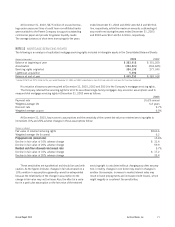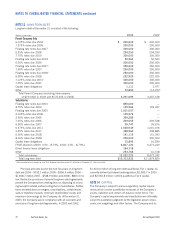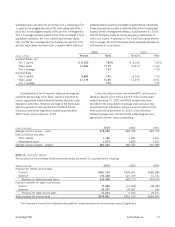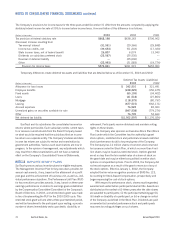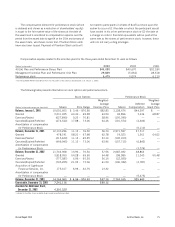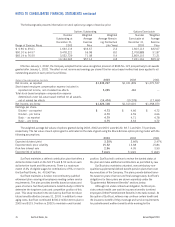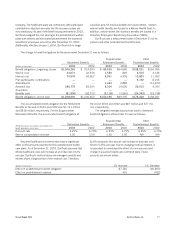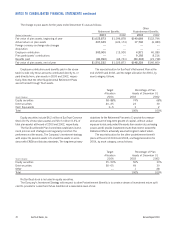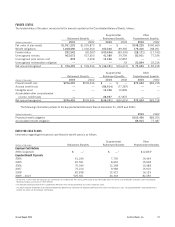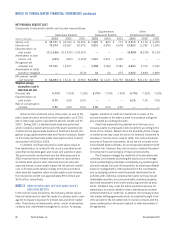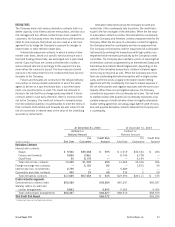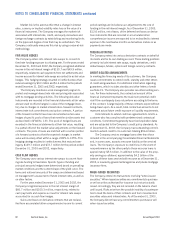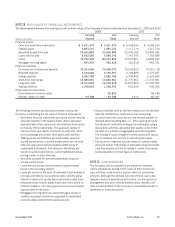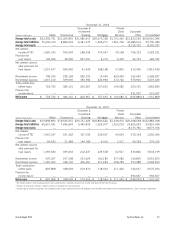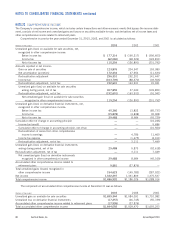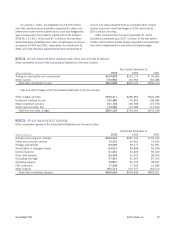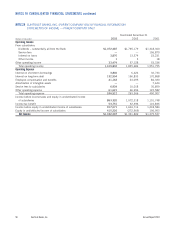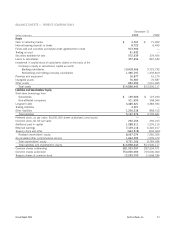SunTrust 2003 Annual Report Download - page 83
Download and view the complete annual report
Please find page 83 of the 2003 SunTrust annual report below. You can navigate through the pages in the report by either clicking on the pages listed below, or by using the keyword search tool below to find specific information within the annual report.
Annual Report 2003 SunTrust Banks, Inc. 81
DERIVATIVES
The Company enters into various derivative contracts both in a
dealer capacity, to facilitate customer transactions, and also as a
risk management tool. Where contracts have been created for
customers, the Company enters into transactions with dealers to
offset its risk exposure. Derivatives are also used as a risk man-
agement tool to hedge the Company’s exposure to changes in
interest rates or other defined market risks.
Interest rate swaps are contracts in which a series of inter-
est rate cash flows, based on a specific notional amount and a
fixed and floating interest rate, are exchanged over a prescribed
period. Caps and floors are contracts that transfer, modify or
reduce interest rate risk in exchange for the payment of a pre-
mium when the contract is issued. The true measure of credit
exposure is the replacement cost of contracts that have become
favorable to the Company.
Futures and forwards are contracts for the delayed delivery
of securities or money market instruments in which the seller
agrees to deliver on a specified future date, a specified instru-
ment, at a specified price or yield. The credit risk inherent in
futures is the risk that the exchange party may default. Futures
contracts settle in cash daily; therefore, there is minimal credit
risk to the Company. The credit risk inherent in forwards arises
from the potential inability of counterparties to meet the terms of
their contracts. Both futures and forwards are also subject to the
risk of movements in interest rates or the value of the underlying
securities or instruments.
Derivative instruments expose the Company to credit and
market risk. If the counterparty fails to perform, the credit risk is
equal to the fair value gain of the derivative. When the fair value
of a derivative contract is positive, this indicates the counterparty
owes the Company, and therefore, creates a repayment risk for the
Company. When the fair value of a derivative contract is negative,
the Company owes the counterparty and has no repayment risk.
The Company minimizes the credit or repayment risk in derivative
instruments by entering into transactions with high quality coun-
terparties that are reviewed periodically by the Company’s credit
committee. The Company also maintains a policy of requiring that
all derivative contracts be governed by an International Swaps and
Derivatives Associations Master Agreement; depending on the
nature of the derivative transactions, bilateral collateral agree-
ments may be required as well. When the Company has more
than one outstanding derivative transaction with a single counter-
party, and there exists a legally enforceable master netting
agreement with the counterparty, the mark to market exposure is
the net of the positive and negative exposures with the same coun-
terparty. When there is a net negative exposure, the Company
considers its exposure to the counterparty to be zero. The net mark
to market position with a particular counterparty represents a rea-
sonable measure of credit risk when there is a legally enforceable
master netting agreement, including a legal right of setoff of receiv-
able and payable derivative contracts between the Company and
a counterparty.
At December 31, 2003 At December 31, 2002
Contract or Contract or
Notional Amount Notional Amount
For Credit Risk For Credit Risk
(Dollars in millions) End User Customers1Amount End User Customers1Amount
Derivatives Contracts
Interest rate contracts
Swaps $9,524 $39,468 $ 395 $4,919 $32,344 $ 266
Futures and forwards 4,836 3,861 — 8,746 6,708 —
Caps/Floors 30 8,176 — —6,254 —
Total interest rate contracts 14,390 51,505 395 13,665 45,306 266
Foreign exchange rate contracts —6,129 82 —3,803 50
Interest rate lock commitments 2,795 — — 5,489 — —
Commodity and other contracts 440 29 68 236 2 59
Total derivatives contracts $17,625 $57,663 $ 545 $19,390 $49,111 $ 375
Credit-related Arrangements
Commitments to extend credit $56,584 $56,584 $49,557 $49,557
Standby letters of credit and
similar arrangements 9,843 9,843 9,362 9,362
Total credit-related arrangements $66,427 $66,427 $58,919 $58,919
Total Credit Risk Amount $66,972 $59,294
1Includes both long and short derivative contracts.


